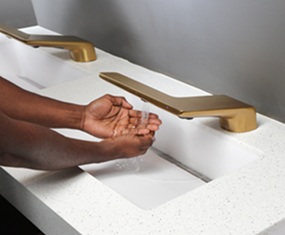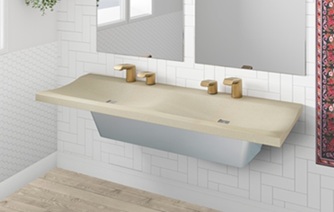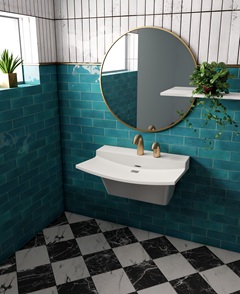 NATIONAL REPORT—In today’s lodging industry, guests are more than travelers—they’re savvy consumers with high expectations for cleanliness, convenience, and corporate responsibility. Whether staying at an upscale resort, boutique inn, or eco-friendly hotel, visitors are increasingly judging establishments by the cleanliness and sustainability of frequently used spaces: the public restrooms.
NATIONAL REPORT—In today’s lodging industry, guests are more than travelers—they’re savvy consumers with high expectations for cleanliness, convenience, and corporate responsibility. Whether staying at an upscale resort, boutique inn, or eco-friendly hotel, visitors are increasingly judging establishments by the cleanliness and sustainability of frequently used spaces: the public restrooms.
Restrooms, which are interspersed throughout lodging venues—including hotel lobbies, restaurants/bars, spas and fitness centers and convention/event centers—represent one of the first guest encounters that hotel patrons experience. It is vital for these high-traffic spaces to be clean and stocked, easy to use and aesthetically pleasing.
According to Bradley’s Healthy Handwashing Survey, 84 percent of Americans say an unclean or unpleasant restroom leaves a negative impression of the entire business. On the flip side, 71 percent say they’re more likely to return—and even spend more money—at a facility with well-maintained public bathrooms.
For hospitality operators, upgrading public restrooms with thoughtful design elements, smart fixtures, and hygienic materials can boost guest satisfaction, support sustainability, and improve operational efficiency. Many of these design strategies can also be incorporated into guest bathrooms for ensuring a consistently elevated experience throughout a hotel stay.
In addition, as more hospitality organizations pursue LEED certification and incorporate ESG standards, restrooms present an excellent opportunity to reduce water, energy and unnecessary waste, and promote occupant health through better materials and design.
Touchless Technology: A Hygiene & Sustainability Win
Sensor-activated fixtures—like touchless faucets, soap dispensers, toilets, and hand dryers—have become the gold standard in public restrooms. Besides being universally easy to use, hands-free operation minimizes cross-contamination and limits the spread of germs, meeting growing hygiene expectations from guests and staff alike.
According to the Healthy Handwashing Survey, nearly 80 percent of Americans think it’s important for public restrooms to be equipped with touchless fixtures and prefer to use touch-free technology over manual options. Many touchless restroom fixtures are easier for staff to clean and refill due to smart technology features.
Their benefits extend beyond hygiene and user convenience. Touchless faucets also help conserve water by delivering water only when needed. Many models have integrated mechanics to help discourage tampering.
From the perspectives of sustainability, maintenance, and guest satisfaction, touchless technology is becoming a standard feature in public restrooms and is also an enhancement being incorporated into guest bathroom design.
All-in-One Handwashing Fixtures: Smarter by Design
 Another type of innovation gaining momentum in public restrooms is all-in-one handwashing solutions that combine soap, water, and hand dryer in a single unit.
Another type of innovation gaining momentum in public restrooms is all-in-one handwashing solutions that combine soap, water, and hand dryer in a single unit.
These systems reduce the number of separate fixtures needed, cutting down on materials and maintenance. Some all-in-one handwashing models are engineered to prevent water from dripping across counters and floors, reducing slip hazards and extra floor cleanup.
By keeping soap, water, and drying functions in one compact space, these fixtures not only improve user accessibility, but they also reduce the need for paper towels, frequent soap refill trips, and increased maintenance. As an added bonus, their sleek design contributes to a modern, up-to-date aesthetic that aligns with today’s green and high-tech branding.
Eco-Conscious Refills Assist Waste Management
Maintenance often drives the environmental footprint of restrooms. Frequent refills, excess packaging, and wasted product all add up. That’s where refill innovations and smart dispensers can make a real difference:
- Top-Fill Multi-Feed Soap Systems: These allow maintenance teams to refill multiple soap dispensers from a single hub, minimizing labor and reducing plastic waste from single-use cartridges.
- Refill Indicators: Smart soap and towel dispensers feature LED alerts when supplies or batteries run low. This helps avoid unnecessary refills and wasted product while ensuring guests never experience an empty dispenser.
- Towel Dispensers with Jam Prevention: Modern paper towel units are engineered with easy-feed mechanisms and anti-jam designs that reduce waste and maintenance headaches, improve usability, and prevent user frustration.
Sustainable Materials & Certifications
Choosing the right materials for restroom fixtures is just as important as layout and technology. Today’s eco-forward hotels are opting for:
- GREENGUARD-Certified Materials: These are tested to emit low levels of VOCs, improving indoor air quality and reducing the risk of allergic reactions or chemical sensitivity. A must for wellness-minded properties and WELL Building Standard certifications.
- Hygienic Solid Surface and Natural Quartz: Seamless, nonporous and long-lasting surfaces that resist staining and bacterial growth require fewer harsh cleaning chemicals.
- Durable, Corrosion-Resistant Finishes: Look for finishes that are fingerprint-resistant and easy to clean. This will minimize frequent touch-ups and support long-term sustainability by extending product lifespan.
Layout, Design & Guest Experience
 Public restroom sustainability doesn’t stop at fixtures—it extends to the layout and user experience.
Public restroom sustainability doesn’t stop at fixtures—it extends to the layout and user experience.
- Spacious, Accessible Design: ADA-compliant layouts that are easy to navigate reduce stress for all guests and create a more inclusive environment. Spacious stalls also reduce contact with surfaces, boosting cleanliness and guest comfort.
- Privacy Restroom Partitions: Lack of privacy in public restrooms is a pain point for many users. According to Bradley’s survey, 72 percent think that toilet stalls don’t provide sufficient privacy, and 53 percent would like the gaps around the stall door and where the stalls come together to be eliminated. Therefore, today’s designers are opting for full-height partitions that eliminate gaps and enhance user comfort. New partition designs incorporate ultra-private, gap-free enclosures that extend from floor to ceiling and are custom-engineered to the precise dimensions of each restroom.
- Occupancy Indicators: Simple visual signals that show stall availability help reduce wait times and foot traffic. Some airports already use stall monitors to improve flow and reduce energy usage tied to restroom lighting and ventilation.
- Shelves, Hooks & Comfort Features: These small additions—especially appreciated by female guests—prevent personal items from touching floors and add a sense of care to the restroom experience.
Final Thoughts: Elevating the Eco-Restroom Experience
Public restrooms have long been a fundamental component of hospitality operations; today, they have elevated guest expectations, public health considerations, and impact sustainability efforts. Facilities that invest in thoughtful, hygienic, and environmentally responsible restroom design don’t just reduce water and energy usage—they gain loyalty from eco-conscious travelers and operational peace of mind.
See related sidebar.
About the Author

Kris Alderson, MBA, LEED AP, is Senior Marketing Manager for Bradley Co., the 100-year-old global manufacturer of commercial plumbing fixtures, washroom accessories, emergency safety fixtures and electric tankless water heaters, now a division of Watts Water Technologies.





